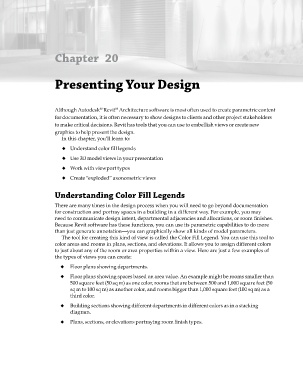Page 857 - Divyank Tyagi
P. 857
Chapter 20
Presenting Your Design
®
Although Autodesk Revit Architecture software is most often used to create parametric content
®
for documentation, it is often necessary to show designs to clients and other project stakeholders
to make critical decisions. Revit has tools that you can use to embellish views or create new
graphics to help present the design.
In this chapter, you’ll learn to:
◆ ◆◆ Understand color fill legends
◆ ◆◆ Use 3D model views in your presentation
◆ ◆◆ Work with viewport types
◆ ◆◆ Create “exploded” axonometric views
Understanding Color Fill Legends
There are many times in the design process when you will need to go beyond documentation
for construction and portray spaces in a building in a different way. For example, you may
need to communicate design intent, departmental adjacencies and allocations, or room finishes.
Because Revit software has these functions, you can use its parametric capabilities to do more
than just generate annotation—you can graphically show all kinds of model parameters.
The tool for creating this kind of view is called the Color Fill Legend. You can use this tool to
color areas and rooms in plans, sections, and elevations. It allows you to assign different colors
to just about any of the room or area properties within a view. Here are just a few examples of
the types of views you can create:
◆ ◆ Floor plans showing departments.
◆ ◆ Floor plans showing spaces based on area value. An example might be rooms smaller than
500 square feet (50 sq m) as one color, rooms that are between 500 and 1,000 square feet (50
sq m to 100 sq m) as another color, and rooms bigger than 1,000 square feet (100 sq m) as a
third color.
◆ ◆ Building sections showing different departments in different colors as in a stacking
diagram.
◆ ◆ Plans, sections, or elevations portraying room finish types.
c20.indd 823 5/3/2014 11:59:57 AM

